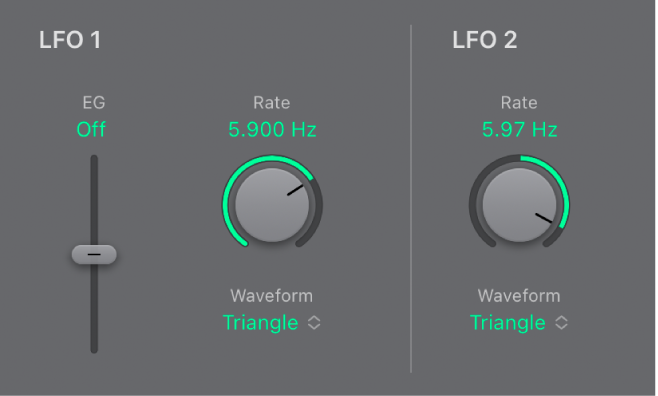Logic Pro User Guide for iPad
- What’s new in Logic Pro 1.1
-
- What is Logic Pro?
- Working areas
- Work with function buttons
- Work with numeric values
-
- Intro to tracks
- Create tracks
- Create tracks using drag and drop
- Choose the default region type for a software instrument track
- Select tracks
- Duplicate tracks
- Reorder tracks
- Rename tracks
- Change track icons
- Change track colors
- Use the tuner on an audio track
- Show the output track in the Tracks area
- Delete tracks
- Edit track parameters
- Start a Logic Pro subscription
- How to get help
-
- Intro to recording
-
- Before recording software instruments
- Record software instruments
- Record additional software instrument takes
- Record to multiple software instrument tracks
- Record multiple MIDI devices to multiple tracks
- Record software instruments and audio simultaneously
- Merge software instrument recordings
- Spot erase software instrument recordings
- Replace software instrument recordings
- Capture your most recent MIDI performance
- Use the metronome
- Use the count-in
-
- Intro to arranging
-
- Intro to regions
- Select regions
- Cut, copy, and paste regions
- Move regions
- Remove gaps between regions
- Delay region playback
- Trim regions
- Loop regions
- Repeat regions
- Mute regions
- Split and join regions
- Stretch regions
- Separate a MIDI region by note pitch
- Bounce regions in place
- Change the gain of audio regions
- Create regions in the Tracks area
- Convert a MIDI region to a Drummer region or a pattern region
- Rename regions
- Change the color of regions
- Delete regions
- Create fades on audio regions
- Access mixing functions using the Fader
-
- Intro to Step Sequencer
- Use Step Sequencer with Drum Machine Designer
- Record Step Sequencer patterns live
- Step record Step Sequencer patterns
- Load and save patterns
- Modify pattern playback
- Edit steps
- Edit rows
- Edit Step Sequencer pattern, row, and step settings in the inspector
- Customize Step Sequencer
-
- Effect plug-ins overview
-
- Instrument plug-ins overview
-
- ES2 overview
- Interface overview
-
- Modulation overview
-
- Vector Envelope overview
- Use Vector Envelope points
- Use Vector Envelope solo and sustain points
- Set Vector Envelope segment times
- Vector Envelope XY pad controls
- Vector Envelope Actions menu
- Vector Envelope loop controls
- Vector Envelope release phase behavior
- Vector Envelope point transition shapes
- Use Vector Envelope time scaling
- Use the Mod Pad
- Modulation source reference
- Via modulation source reference
-
- Sample Alchemy overview
- Interface overview
- Add source material
- Save a preset
- Edit mode
- Play modes
- Source overview
- Synthesis modes
- Granular controls
- Additive effects
- Additive effect controls
- Spectral effect
- Spectral effect controls
- Filter module
- Low and highpass filter
- Comb PM filter
- Downsampler filter
- FM filter
- Envelope generators
- Mod Matrix
- Modulation routing
- Motion mode
- Trim mode
- More menu
- Sampler
- Copyright
Use ES2 LFOs in Logic Pro for iPad
ES2 LFOs can be used to create delayed modulations, free modulations, and modulations that are synchronized with the Logic Pro tempo.

Set the LFO 1 modulation fade time in ES2
In Logic Pro, set a positive LFO 1 EG value to fade in the modulation.
The higher the value, the longer the delay time.
Set a negative LFO 1 EG value to fade out the modulation.
The lower the slider is positioned onscreen, the shorter the fade out time.
Set up a delayed vibrato in ES2
LFO envelopes are most often used for delayed vibrato—many instrumentalists and singers intonate longer notes this way.
In Logic Pro, set the LFO 1 EG slider to a position in the upper half (Delay) and modulate the Pitch123 target with the LFO 1 source in Mod Matrix Slot 1—10.

Set a slight modulation intensity with the Amount slider.
Set an LFO 1 Rate of about 5 Hz.
Choose the triangular wave as the LFO 1 waveform.
Set a free rate for LFO 2 in ES2
In Logic Pro, choose a value in the upper half of the LFO 2 Rate range to run LFO 2 freely.
The rate is displayed in hertz.
Synchronize the ES2 LFO 2 rate with the song tempo
In Logic Pro, choose a value to the left of the LFO 2 Rate center position to synchronize LFO 2 with the project tempo.
The rate is displayed in rhythmic values (when project tempo synchronization is active).
Synchronized rates range from speeds of 1/64-notes to a periodic duration of 32 bars. Triplet and punctuated values are also available.
Download this guide: PDF